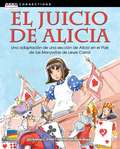- Table View
- List View
El huerto del Sr. Soto (¡Arriba la Lectura!, Level M #21)
by Ann Weil Scott GotoNIMAC-sourced textbook. ¡Recuerden mezclar un poco de cenizas con la tierra cuando estén plantando papas! Esto no puede ser correcto, ¿o sí? Pues es lo que Josefina y Alberto deben descubrir cuando un desafortunado accidente los pone al frente del huerto del señor Soto.
El invierno (¡Arriba la Lectura!, Level K #45)
by Elsie NelleyNIMAC-sourced textbook. Mantener el calor en invierno puede ser difícil. La fría nieve puede ser profunda y, a veces, peligrosa. ¿Qué hacen los animales y los seres humanos para mantener el calor durante el invierno y cuáles son sus actividades?
El jardín curioso (¡Arriba la Lectura!, Read Aloud Module 9 #2)
by Peter BrownNIMAC-sourced textbook
El juego de Egipto (¡Arriba la Lectura!, Trade Book #9)
by Alton Raible Zilpha SnyderNIMAC-sourced textbook
El juicio de Alicia: Una adaptación de una sección de Alicia en el País de las Maravillas de Lewis Carroll
by Lewis Carroll Kathryn L. O'Dell David ShepardNIMAC-sourced textbook
El kimono de Suki (¡Arriba la Lectura!, Read Aloud Module 1 #3)
by Chieri Uegaki Stéphane JorischNIMAC-sourced textbook
El largo sendero de Texas (¡Arriba la Lectura!, Level U #51)
by Loretta West John Manos Diana Kizlauskas Natalie WestTras perder a sus padres a causa de la fiebre amarilla, Paula empieza a vestirse y a comportarse como un niño para poder acompañar a su abuelo en el viaje de transporte de ganado. ¿Volverá algún día su vida a la normalidad? NIMAC-sourced textbook
El legendario pan de Beauchamp (¡Arriba la Lectura!, Level R #14)
by Richard Hoit Quentin FlynnEn esta fábula, monsieur Lapin es el panadero de una pequeña aldea. Cuando los aldeanos deciden ayudarlo, las cosas terminan en desastre. ¡Así es como todos descubren que el pan de monsieur Lapin tiene un ingrediente secreto! NIMAC-sourced textbook
El libro de lo importante (¡Arriba la Lectura!, Read Aloud Module 2 #1)
by Leonard Weisgard Margaret BrownNIMAC-sourced textbook
El libro de los museos: Una guía de colecciones extrañas y maravillosas (¡Arriba la Lectura!, Trade Book #10)
by Jan Mark Richard HollandNIMAC-sourced textbook
El maravilloso ciclo del agua (¡Arriba la Lectura!, Level L #52)
by Lisa ShulmanEl agua puede estar en tres estados: sólido, líquido y gaseoso. Lee cómo ocurren estos estados en el ciclo del agua. NIMAC-sourced textbook
El mejor animal del bosque: Obra de teatro (¡Arriba la Lectura!, Level J #73)
by Phillip Simpson Jo ThapaNIMAC-sourced textbook
El mensaje oculto de Lizzie (¡Arriba la Lectura!, Level Q #44)
by Julie Ellis Christen StewartNIMAC-sourced textbook
El misterio de Marisol (¡Arriba la Lectura!, Level H #53)
by Leslie Arnott Sergi CamaraPronto será el cumpleaños de Marisol. ¡Lee y sabrás qué misterio hay alrededor de su cumpleaños! NIMAC-sourced textbook
El misterio de Naranjal (¡Arriba la Lectura!, Level S #67)
by Jill McDougall Scott FraserNIMAC-sourced textbook. Cuando Alicia, Beca y Cris viajan a Naranjal, Cris presiente que pasarán unas vacaciones aburridas. Pero cuando los tres amigos observan a un hombre sospechoso con un paquete extraño, Cris se da cuenta de que la pandilla ABC se ha topado con un nuevo misterio. ¡Y no será fácil de resolver!
El misterio de las fresas perdidas (¡Arriba la Lectura!, Level J #75)
by Richard Hoit M. C. HallNIMAC-sourced textbook
El misterio de las monarca (¡Arriba la Lectura!, Level E #22)
by Daniel Shepard Dan GrantEl maestro trajo una planta a la escuela. Hay un huevo en la planta. ¡Algo muy lindo va a pasar! NIMAC-sourced textbook
El misterio del gato inteligente (¡Arriba la Lectura!, Level J #18)
by Vicki Learner Patricia PfitschCanelo es un gato inteligente. ¿Cómo entra por su cuenta a la casa? ¡Es un misterio! NIMAC-sourced textbook
El misterio del libro perdido (¡Arriba la Lectura!, Level O #49)
by Natalie West Vagreti CockrilleNIMAC-sourced textbook. Julia es la nueva columnista de consejos del periódico de tercer grado. Cuando recibe su primera carta, se entera de que alguien vio quién se llevó el libro de la maestra Smith. ¿Podrán ella y su mejor amiga, Gladys, resolver el misterio del libro perdido?
El misterio del monstruo de la bahía (¡Arriba la Lectura!, Level J #19)
by Margaret Fetty Sean O'NeillKeisha y Vince ven algo en el agua. ¿Será Chessie, el monstruo de la bahía? NIMAC-sourced textbook
El misterio del número 7 (¡Arriba la Lectura!, Level Q #82)
by Jill McDougall Scott FraserNIMAC-sourced textbook. A Alicia le encantan las historias de misterio. Forma parte de la banda ABC, un grupo que está siempre buscando misterios. Cuando una vecina fuera de lo común se muda a la casa de al lado, ella y sus amigos sienten la necesidad de investigar. El resultado los va a sorprender. Pero, ¿quizá las cosas no son lo que parecen?
El misterioso canto de las sirenas (¡Arriba la Lectura!, Level V #72)
by James Hart John ParsonsEn esta adaptación de la epopeya griega, Timoneo está decidido a no dejarse llevar por el misterioso canto de las sirenas de Antemusa, capturar a esas criaturas y enriquecerse. Pero en lugar de eso… ¡comete un error terrible! NIMAC-sourced textbook
El momento de gloria de Dora (¡Arriba la Lectura!, Level O #51)
by Becky Radtke Aurora GarcíaNIMAC-sourced textbook. A Dora le encanta el fútbol y su equipo. Una lesión le impide jugar y aprovecha ese tiempo para leer sobre la Copa del Mundo. Sueña con jugar en esa competencia famosa. ¿Será capaz de recuperarse de la lesión y llevar a su equipo a la victoria?
El monstruo del ático (¡Arriba la Lectura!, Level F #33)
by Lisa Trumbauer Sergi Camara¡Bum! ¡Tap! ¡Tap! ¡Crunch! ¿Hay un monstruo en el ático? ¿O qué más puede ser? NIMAC-sourced textbook
El monte Santa Helena: La explosión de una montaña (¡Arriba la Lectura!, Level N #83)
by Gary Miller¿Has oído hablar del monte Santa Helena? Lee sobre esta montaña que también es volcán. NIMAC-sourced textbook

